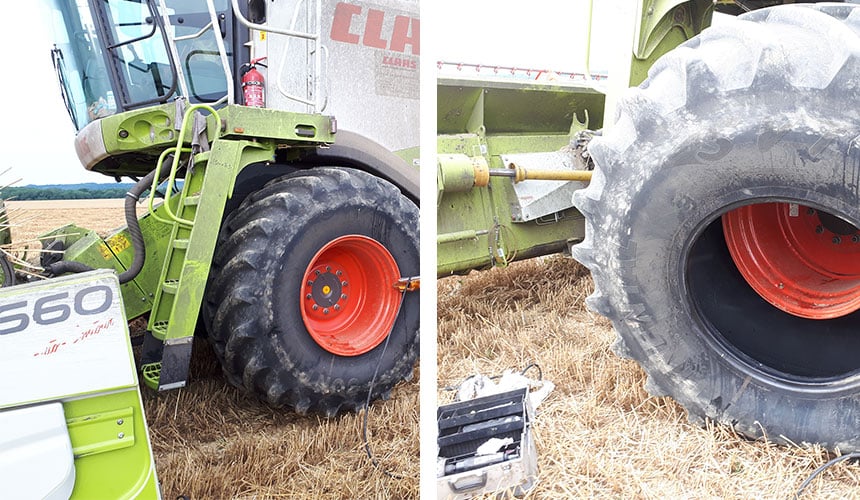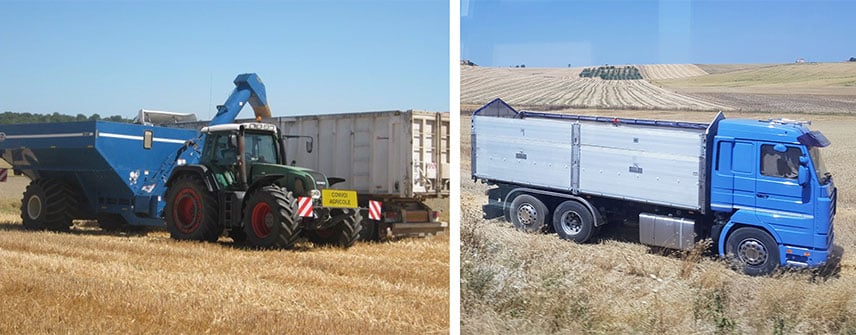Did you know that that most incidents involving harvesting tyres occur at the very beginning of the season and that the issues arising are generally the consequences of a problem encountered during the previous season?
A minor impact to the sidewall, improper storage during the winter, driving with an excess load during the preceding harvest often lead to weak points which could result in the immobilisation of your equipment just when you really need it.
In the same way as your combine harvester needs servicing at the beginning of a harvesting campaign, a tyre check-up is relatively simple and can save you from a critical problem at the worst possible time.
In this article we look at what aspects of your tyres you need to check and how to prepare for your next harvesting campaign.
1. What effect could badly prepared harvesting tyres have on my productivity?
Before the harvest, a mechanical check-up of the harvester is obviously necessary to prevent engine failure at the worst possible time.
Checking the state of your tyres may seem secondary, but tyre damage could be as much of a nuisance as a mechanical problem and would force you to stop operations at the most inopportune moment.
Potential problems due to incorrect inflation pressure
Increasing the load and preserving your soil are two opposing requirements. To save time, we tend to increase the load and therefore work at a very high inflation pressure (3.5 to 4 bar).
But for soil preservation purposes pressure must be reduced, forcing you to limit the load in the hopper and empty it more frequently. It’s difficult to choose between the two options, and unfortunately opting for a compromise with an average pressure of around 3 bar is good for neither situation.

If you wish to work with a maximum load and your tyres are underinflated, they will flatten out excessively and have great difficulty resisting the load.
This may result in the tyre coming off the rim or bursting.
On the other hand, if you limit the load and empty the hopper regularly, with a pressure of 3 bar you will compact the soil more than necessary whereas you could have inflated your tyres to around 2.4 bar to preserve your soil.
Whatever the scenario, the inflation pressure must be calculated meticulously, knowing the difference in load between the empty harvester and the loaded harvester.
The load effectively has a major impact on your tyres, which have to compensate for the extra kilos of a full hopper thanks to their deflection capacity.
What are the risks of working with tyres that have not been prepared?
Whether it be on the road or in the fields, what farmers fear most is having to stop in the middle of their operations to deal with a breakdown, whether mechanical or due to a puncture.

A tyre that has not been prepared, whose pressure has not been checked, with a used tread or whose lugs or sidewalls are showing signs of weakness, may puncture where a tyre in good condition will pass without any problem.
A puncture leads to the immobilisation of your machine, making you lose precious time and leading to on-site repair costs, which are never welcome.
How long does it take to repair a harvesting tyre on site?
Repairing a tyre in the fields is not an easy task. The time required depends on the type of damage and the technician in charge of carrying out the repair work. If you have a puncture, and you are on good terms with your agricultural tyre dealer who has a team of efficient, professional technicians, with the emergency response vehicles and equipment necessary, the problem will no doubt be dealt with rapidly.

Unfortunately with a combine harvester it can be more tricky than for a tractor. If the technician has the right size of tyre available, it will take at least 4 hours to reach you and replace your tyre following a puncture, but the job could take several days if the right tyre is not in stock.
2. A few check-up points to avoid problems with my harvesting tyres
Your harvesting tyres must be inspected and maintained regularly, especially before the beginning of the new harvesting campaign. This check-up procedure only requires about ten minutes and can help you anticipate potential problems.
Examine your tyres in static position
The first inspection of your harvesting tyres has to be carried out while the machine is stationary, paying careful attention to the following points:
- The treads, sidewalls, rim, bead: look closely for the presence of any foreign substances, irregularities or impacts.
- The wheel bolts: check for signs of corrosion, a loose screw, etc.
- The valve caps: make sure they are present and screwed on tightly to ensure there is no loss of airtightness when driving.
- The lugs: the state of the lugs must be examined meticulously because irregular wear could be the sign of a problem with parallelism or a slow puncture leading to loss of pressure.
- Pressure: this must correspond to manufacturer recommendations, because badly adapted pressure leads to tyre wear on the road, accentuates soil compaction in the fields and increases your fuel consumption during the harvest.
Examine your tyres while driving
The second inspection takes place while driving. Repair work is necessary in the following cases:
- Abnormal vibrations: these may be caused by a mechanical defect, incorrect mounting or a pressure problem.
- Faulty road handling: this problem is generally linked to the wrong inflation pressure settings.
- Abnormal bounce or swing: this is often due to bad load transfer conditions or overinflation of the tyres.
If you identify any of the anomalies listed above during your inspection, it would be preferable to consult your tyre dealer straight away, to look further into the causes and consequences of the problem and avoid a potential breakdown during the harvesting campaign.
3. What is the most suitable harvesting tyre if you need a replacement?
If you discover a major problem and you take the decision to replace a set of tyres on your harvester, it is best to opt for a specific model which will help you improve your machine’s efficiency, save time, boost productivity and preserve your soil.
Choose tyres that can carry greater loads to save time
There are currently highly efficient harvesting tyres on the market, such as IF CFO or VF CFO (Cyclic Field Operations) tyres.
These have a robust casing, which is more solid and reliable, enabling them to bear more weight than standard agricultural tyres.
Their structure has been reinforced so that they can bear up to 55% more load than a standard agricultural tyre. This means that you can travel greater distances without stopping and cover several hectares more each day.
These new generation tyres have an innovative lug design which optimises tractive force.
How to limit the impact of harvesting tyres on my soil?
In addition to choosing a quality tyre that is adapted to harvesting, you can adopt a few simple habits to reduce the impact on your soil:
Check the state of the ground before working in any given field
Wet ground is highly sensitive to compaction, so why not wait a bit before beginning the harvest to avoid damaging your land further.
Harvest slightly before the usual time
To avoid working in wet conditions and to preserve the structure of your soil, you could bring forward the harvesting date by adapting crop maturity dates if this is possible with your crop schedule.
Reduce the load
It is possible to reduce compaction by decreasing the pressure to the ground.
To do so, you must limit the weight of your machine by emptying the hopper regularly and avoid crossing your land with full trailers.
During harvesting, only fill up the trailers when they are situated on the grass slip at the edge of the field.
Drive sensibly
To avoid the impact of trips back and forth with your agricultural machinery, you should always drive in the same place, for example by using an RTK guidance system. This will allow you to set and follow the same path with all your agricultural vehicles.
Empty the hopper at the side of the field
Another option is to empty the hopper at the side of the field directly into trailers which do not enter your fields.
Limiting soil restoration efforts (less decompaction work required, time and fuel savings) easily makes up for the time devoted to these operations.

Certain harvesting tyres contribute towards soil preservation
Transporting heavier loads accentuates soil compaction, especially with unsuitable tyres or inflation pressure. It is therefore best to use tyres which spread the load better for improved soil preservation purposes.

CONCLUSION
Thanks to their very supple and highly resistant sidewalls, IF CFO and VF CFO tyres have a greater flexion capacity and provide a larger soil footprint, which reduces pressure and minimises soil compaction in your fields, despite the load.
The Bridgestone-agriculture.eu blog is written and administered by tractor tyre experts who are available to provide you with the advice you need on the subject of your agricultural tyres. They allow you to maximise your productivity with information on all subjects linked to tyres: Cheap tractor tyres — Technical data for agricultural tyres — Air pressure advice — Solutions to avoid soil compaction — Sprayer tyre pressure — Why and how to ballast your tractor tyres — When to use dual wheels — The mechanical causes of abnormal wear — Cheap agricultural tyres – etc.
To learn more and boost your farm's profits, Bridgestone-Agriculture is offering you a free, detailed white paper that explains the essential role your agricultural tyres play in your productivity.
Most people who read this article have also read some of the following articles:
- 5 essential techniques to optimise your agricultural tyres
- What are agricultural tyres’ high-strain zones?
- Should you change the rim for wide agricultural tyres?
- Is a premium rim better suited to my tractor tyres?
- What is the link between the environmental impact of tyres and your profitability
- Braking capacity: role and impact of the agricultural tyre
- Are adjustable rims better than welded rims?
- How reliable are your agricultural tyres when cornering?
- How do you ensure that your tractor tyres have a good self-cleaning capacity?
- What is the mechanical performance of an agricultural tyre?
This information is intended only to make you aware of the technical and functional aspects of agricultural tires and their use. It does not allow you to make a judgment or a definitive conclusion on a given problem. Only your agricultural tire expert is able to make a technical assessment and take a final decision, case by case.
Leave a
commentary
Your email address will not be published.
Required fields are indicated with *








